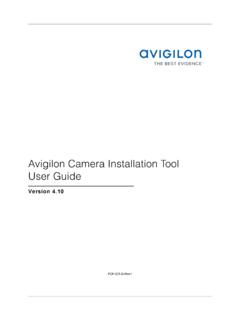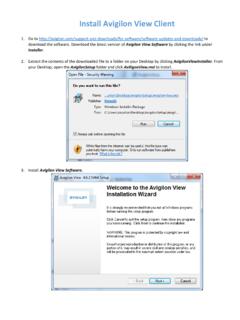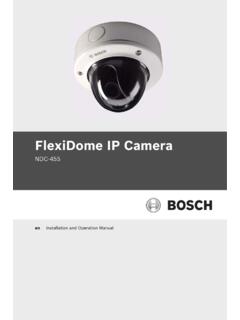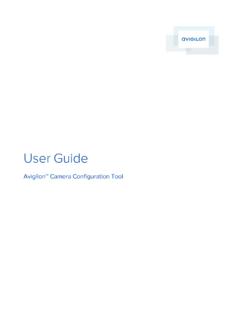Transcription of Designing a Site with Avigilon Self-Learning Video Analytics
1 Designing a Site with Avigilon Self-Learning Video Analytics Avigilon HD cameras and appliances with Self-Learning Video Analytics are easy to install and can achieve positive Analytics results without ongoing software adjustments. Avigilon 's patented Self-Learning Video Analytics automatically adjust to the camera 's field of view (FoV) requiring no configuration or adjustment. For Video Analytics to perform effectively, the Analytics cameras (or cameras connected to an ACC ES Analytics Appliance) must be installed correctly. Video Analytics enabled cameras must be: l Within the height and angle guidelines. l Level to the horizon and ground plane (for outdoor or large indoor areas).
2 L Installed where there is sufficient light in the area of interest with no obstructions. l Within range of the area of interest for the Video Analytics to identify objects. l Monitoring a scene with enough contrast to classify objects in the scene. For example, a person walking in white clothes in a snow-covered FoV may provide poor results. The following information provides a basic set of installation parameters. Read through the entire document before installing cameras. For site requirements that deviate from the listed recommendations, or when in doubt, consult with an Avigilon representative before installing the cameras. General Guidelines 2. Analytics Location Mode 3.
3 Reflected Light 4. Adaptive IR 4. Lux on Target 5. Obstructions 5. Coverage Area 6. Object Velocity 7. Outdoor camera Placement 7. Self-Learning 8. Avigilon Appearance Search Feature 9. Designing a Site with Avigilon Self-Learning Video Analytics 1. For More Information 11. General Guidelines In general, cameras should be installed according to the following guidelines to achieve optimal Analytics performance: l Cameras must be able to see moving objects in the field of view (FoV) for a minimum of 2 seconds. l 5 seconds is recommended for optimal object classification. l Cameras should be mounted at a minimum of meters (9 feet). l Cameras can be tilted within 30 from the horizontal for optimal object classification.
4 O Increasing the tilt angle can help in detecting targets that are directly approaching the camera . o The camera should be tilted no more than 45 from the horizontal. l Cameras should be mounted to a stable surface to minimize vibration and movement. l Select a lens, mounting height and tilt to capture the required level of detail for classified object detection within the scene. General Guidelines 2. l camera FoV must be level with the horizon. l People in the FoV should be walking upright. l People and cars moving parallel to the FoV provide better results than objects moving to or from the camera . For more details related to your particular type of camera or scene, see the related section.
5 For more details related to Avigilon Appearance Search feature, see Avigilon Appearance Search Feature on page 9. NOTE: Analytics on wide-angle or fisheye/panoramic lenses are not supported at this time. Analytics Location Mode In the Avigilon Control Center (ACC) Client software, set the camera 's Video Analytics Configuration to use the Location mode that best describes the scene: l Outdoor this option is suitable for most outdoor environments. This setting optimizes the camera to identify vehicles and people. l Outdoor High Sensitivity only use this option if you require the system to be more sensitive than the Outdoor setting. This option is optimized to run with higher sensitivity for detecting people and vehicles in challenging outdoor scenes.
6 Be aware that this option will generate more false positives. l Large Indoor Area this option only detects people and is optimized to detect people around obstructions, like chairs and desks, if the head and torso are visible. l Indoor Overhead this option is optimized for cameras mounted directly overhead and should only be used when a torso cannot be seen in the camera FoV. Any movement is assumed to be human. It can be used in areas with limited space but with high ceilings, or to monitor doors. It should not be used with the Avigilon Appearance Search feature, or to detect people traveling against the crowd. Analytics Location Mode 3. Reflected Light l Avoid direct light sources.
7 The camera may be temporarily blinded if bright light sources shine directly at the camera . l Position the camera so that the sun, headlights or other light sources do not shine directly into the lens. l Avoid installing the camera in areas with drastic changes in lighting throughout the day. For example an indoor space with direct sunlight through a skylight or large windows. o Significant changes in lighting cause large shadows and different coloring in the space. Such changes may generate inconsistent detection results. l Be conscious of indirect light sources, including reflections from built-in or external IR illuminators, to avoid lens flares and loss of contrast in the image.
8 O Cameras with wide dynamic range (WDR) may be able to overcome this issue in some instances. l Avoid mirrors and other reflective surfaces (like shiny floors and ceilings). Reflections may cause additional false detections. Adaptive IR. Adaptive IR functions by adjusting the IR output dynamically to prevent oversaturation in the scene as the light changes throughout the night. l Cameras using only built-in IR for illumination at night detect targets at a much shorter distance. Additional illumination is required to consistently detect targets. l Be aware that IR may also blur the outline of objects and negatively impact the accuracy of the Video Analytics . o You can disable adaptive IR to help improve classified object detection in the scene.
9 Reflected Light 4. Lux on Target l The recommended minimum illumination is 8 lux on target for analytic cameras. l For non-analytic, third-party cameras that are connected to the ACC ES Analytics Appliance, the minimum illumination requirement varies from camera to camera . o More light is required if the third-party camera does not have an IR cut filter or a monochromatic night mode. l For illuminating distances, it is important to account for lighting, weather, contrast and camera stability conditions. o In bad weather with low visibility, Analytics should be combined with other detection methods to ensure a secure system. Contact your Avigilon representative for advice on installing in challenging lighting situations.
10 Obstructions To identify objects accurately, the scene must be clear. l For outdoor applications, avoid placing a camera where the FoV includes foliage, terrain or large objects that occlude the subjects of interest. o Also pay attention to obstructions that can reflect IR illumination back to the camera and cause reduced contrast or overexpose camera Video at night. This can be corrected by adjusting any of the following: l Separate the IR illuminators. l Adjust the camera placement. l Correct the aim of the IR illuminators or the camera . l For indoor applications, a person may be detected as long as their upper body, including head and shoulders, is visible. o It is recommended that a person be fully visible for the Avigilon Appearance Search feature to provide better matching search results.












